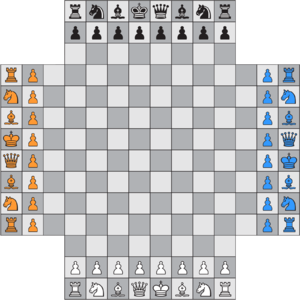
- Chess World Cup
- FIDE Grand Prix
- Olympiad
- World Championship
- List of strong tournaments
- List of world championships

- Checkmate patterns
- Chess openings
- Chess strategy
- Chess tactics
- Chess theory
- Endgames
- Pawn structure
- Problems/Compositions













A popular four-player chessboard and initial setup
|
|
| Genre(s) | Abstract strategy game Chess variant |
|---|---|
| Players | 4 |
| Random chance | None |
| Skill(s) required | Strategy, tactics |
| Synonym(s) | Four-handed chess Four-man chess Four-way chess |
Four-player chess (also known as Four-handed, Four-man, or Four-way chess) is a family of chess variants typically played with four people. A special board made of standard 8x8 squares with an additional 3 rows of 8 cells extending from each side is common. Four sets of differently colored pieces are needed to play these variants. Four-player chess follows the same basic rules as regular chess. There are many different rule variations; most variants, however, share the same board and similar piece setup.
The Cox-Forbes theory of the origin of chess asserts that a four-player version was the earliest form of the game. This theory has long since been debunked, but a description of a four-player chess game is found in an Indian text written c. 1500. The Tithitattva of Raghunandana describes such a version, which continued to be played into the 20th century.
The first documented example of a modern four-player chess system was written by Captain George Hope Verney in England in 1881.
The most common form of play is two vs. two in which allied pieces cannot eliminate each other, but help the others in defense and offense. The allied players sit across from each other and help checkmate the people to the left and right of them. The game is over when both opposing kings are checkmated. If only one can be checkmated, the game is a draw.
Singles is substantially harder than team play. In this method, each player can attack any of the other three players and vice versa. Once a player is checkmated, the checkmated player can either remove their pieces from the board, or the player that checkmated can use the remaining pieces during that player's turn. Play continues until only one player remains.